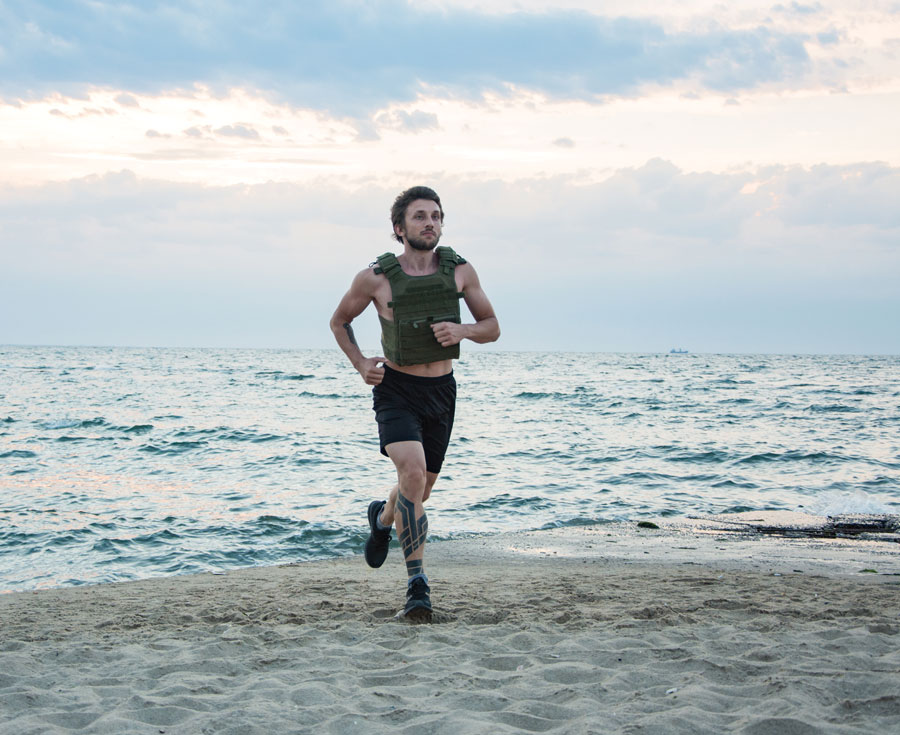
Obesity is a common condition among older adults, which negatively influences physical mobility limitations. Regular exercise and weight management helps to improve physical activity and mobility. Naturally, weight loss is associated with loss muscle mass, due to the amount of stress on the muscles being reduced as weight loss decreases. To preserve muscle mass, using a weighted vest can help reduce the amount of muscle mass lost.1
Benefits of Weighted Vests
A weighted vest adds to a person’s body weight, requiring certain groups of muscles to work more diligently, including the calf muscles, gluteal muscles, and hamstrings. The muscles that support the back, core, and abdomen are also being exerted.1
Weighted vests are suitable for individuals who are not able to walk at high speeds2 and to increase the amount of intensity3 for individuals who have mastered walking and need an additional challenge.2 A weighted vest is worn around the torso. A weighted vest can also help boost and maintain bone mineral density (BMD) due to the weight from the vest targeting the lower body muscles. Weighted vests are appropriate for a variety of walking exercises which can also help improve stability, strength, and relieve pain.2 A weighted vest adds additional weight to the body, leading to more oxygen uptake during walking and hiking while also increasing the number of calories being burned.3
Wearing a weighted vest with a weight of up to eight percent of body mass increases the capacity on the body’s skeletal system, leading to more new bone development and less bone resorption for adults with healthy weights.4
The Link Between Weighted Vests and Weight Loss
A randomized, controlled pilot study analyzed the usefulness of daily weighted vest use with diet and weight management to assess the effects on each participants’ muscles, fat, bones, and the ability to perform physical activities over 22 weeks. This study included 37 male and female participants between the ages of 65 to 79 years with obesity. 20 participants wore the vest and followed the diet plan, while the other 17 participants only followed the diet plan. Both groups had a targeted goal of 10 percent weight loss, consuming between 1,100–1,300 calories per day.1
The vest group wore the vest under their shirts daily, eventually advancing to wearing for a maximum of 10 hours a day. At the beginning of the study, no additional weight was added to the vest—with the initial weight of the vest alone being about 0.5kg. Weekly everyone’s vest weight was increased, determined by their weight loss proportion, with a maximum amount of 15 percent added to the individual’s baseline weight by the end of the study.1
Both groups had a comparable reduction of weight, with no significant disparities between the groups. Overall, individuals in each group also experienced a significant reduction of fat mass, lean mass, and body fat, with no significant disparities between the groups. This study concluded that weighted vest use among older adults with adults is effective in weight reduction and maintaining muscle mass. The average time the vests were worn was over six hours a day, with the goal of ten hours being achieved on two-thirds of the active days. Among both groups, all participants’ body mass index (BMI) decreased from the obese range to overweight at the conclusion of the study, like studies that restricted calorie intake with meal replacements for weight loss management in older adults with overweight and obesity over periods of 12 to 18 months.1
The Bottom Line
Before trying a weighted vest, experts recommend consulting a doctor to ensure a weighted vest is appropriate for you and your fitness goals. Some weighted vests have removable weights. Depending on the brand, vests may be one-size, however, other sizes are available depending on your specific needs. Be sure to pick a vest that fits around your torso snugly with the weights staying in place. Begin using a weighted vest for about 10 to 15 minutes per exercise to allow your body to get used to the vest.2
Sources
- Normandin E, Yow D, Crotts C, et al. Feasibility of weighted vest use during a dietary weight loss intervention and effects on body composition and physical function in older adults. J Frailty Aging. 2018;7(3):198-203.
- Puthoff ML, Darter BJ, Nielsen DH, et al. The effect of weighted vest walking on metabolic responses and ground reaction forces. Med Sci Sports Exerc. 2006;38(4):746–752.
- DeSimone G. The weighted vest: an investment in your workout. ACSMs Health Fit J. 2020;24(2):3–4.
- Kelleher JL, Beavers DP, Henderson RM, et al. Weighted vest use during dietary weight loss on bone health in older adults with obesity. J Osteoporos Phys Act. 2017;5(4):210.





